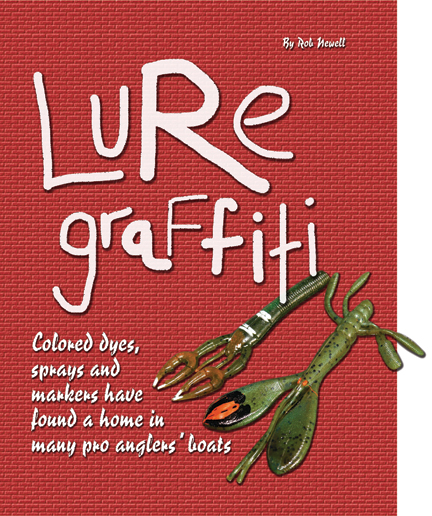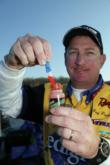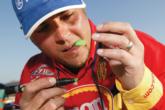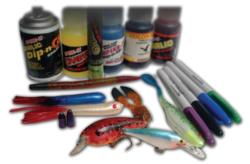Tournament Tested: Lure graffiti
Colored dyes, sprays and markers have found a home in many pro anglers’ boats

I got my first lesson in lure graffiti from well-known bass pro Kevin VanDam of Kalamazoo, Mich.
During a day of practice at the Lake Ouachita Wal-Mart FLW Tour event in 2002, VanDam was fishing with a brown crankbait, a shad-colored flat-sided crankbait and a red lipless crankbait.
After rotating through the baits, he suddenly scored a couple of keepers on the bright red lipless crankbait.
“Red is the deal,” he said, and he quickly dove into his tackle locker.
I only assumed that he would rummage through his crankbaits for something in red. Instead, he emerged with a small spray can.
“Dyes are not just about chartreusing soft plastics,” he said as he doused the two other crankbaits with red spray. “You can make any lure any color you want with these sprays.”
Over the last few years, colored dyes, sprays and markers have found a home in many pros’ boats.
Spike-It Bait Company (ispikeit.com) and Lake Hawk Inc. (lakehawk.com) are two companies that make dips, dyes, sprays, pens and paints in an assortment of colors that are designed for coloring soft and hard baits. Additionally, markers and nail polish also make fantastic expedient coloring devices.
Tyson pro Todd Ary of Birmingham, Ala., and Pedigree pro Greg Pugh of Cullman, Ala., are two of those anglers who carry a small arts-and-crafts department in their boats. They are constantly experimenting with different hues on lures.
 Pugh has built his confidence in coloring baits through experimentation with bedding fish.
Pugh has built his confidence in coloring baits through experimentation with bedding fish.
“On several occasions I have seen color make a tremendous difference on spawning fish,” Pugh said. “I’ve thrown a white jig or tube in a bed with no response from the fish. Then I give the tentacles or jig trailer a shot of blue, and suddenly that same fish is flaring on the bait. To see a fish’s attitude change so drastically over color gives me a lot of confidence in what a change of color can do.”
With so many coloring options available, how do these two anglers know what color to use and when?
Like with anything in fishing, there are no hard, fast rules.
“Part of the fun is creative experimentation,” Ary said. “I get out the sprays and pens and begin tinkering. In order for it to give me the mental edge I desire, it has to be my unique creation. Instead of just chartreusing the tail like everyone else, I might also give the bait an orange throat with a couple of blue dots.”
There are some common denominators that Ary and Pugh share when making color decisions, namely water temperature and timing of the spawn.
“During prespawn, when the water is cold, I go with bolder colors – reds, oranges and blues,” Ary said. “During the spawn and after, I like lighter yellows, chartreuses and greens.”
 Ary’s reasoning is that during the prespawn, he figures crawfish to be a large part of a bass’s diet. But during the spawn and after, small sunfish are not only a threat to spawning sites, but they also become a more readily available food source.
Ary’s reasoning is that during the prespawn, he figures crawfish to be a large part of a bass’s diet. But during the spawn and after, small sunfish are not only a threat to spawning sites, but they also become a more readily available food source.
“Early summer through fall I use a lot of chartreuse because the bass are eating threadfin shad, which have a yellowish tint to their tails,” he said.
Pugh lets the moon phase dictate his color selection because of its bearing on spawning activity.
“So much in freshwater revolves around spawning cycles, which are controlled by moon phases,” Pugh said. “For instance, perch and sunfish all have bright colors when they are spawning. Crawfish, too, exhibit more color in their pinchers. So if I’m fishing anywhere around a full moon, I add bright colors – oranges, reds and chartreuses. But if it’s in between moons, I’ll go with more muted colors – blues and greens.”
In addition to making custom creations, these dyes also allow anglers to change colors without changing lures. As VanDam demonstrated, it is much faster to press a spray nozzle than to dig out another bait and tie it on.
“The markers and pens save me a lot of time on the water,” Ary said. “If I’ve got a shad-colored crankbait tied on and I want chartreuse with a blue back, I just take out my markers and color it.”
With a few cans of spray and bottles of dye, Pugh has been able to remove dozens of bags of plastics from his boat.
“I used to carry every color under the sun,” he said. “But now I carry mostly whites and pumpkins because I can dip all of the blues, greens and purples that I need from those two base colors.”
Said Ary, “For the small amount of space they take up in a boat, dips, sprays and markers are certainly worth the while for quick color changes.”
Colored markers and dyes are not just for lures, either. Pros also use them to color line, weights and beads.
Some braided lines fade and become white with use. Dunking the braid in a dark dye or coloring the first 18 inches above the bait with a marker erases that bleached-out look.
Are your lead or tungsten weights too shiny? Color them with a black or blue marker. The expedient paint job will eventually wear off, especially on tungsten, but it will knock that silvery shine down for a while.
What about spills?
Both Spike-It and Lake Hawk make neutralizers that will aid in removing stains from spilled dyes, but getting your new boat carpet back to mint condition may be difficult if it is a bad spill.
Pete Baldwin of Lake Hawk recommends doing the dip dyeing at home where there are no waves or wind, and taking just markers and sprays in the boat.
“The best way to avoid spills is to leave the dipping dyes at home,” Baldwin said. “If you are going to use dip dyes in the boat, I suggest doing all dipping out over the water or within the confines of a Tupperware-type container.”
If you do spill dye in the boat, Baldwin suggests blotting with the neutralizer immediately.
